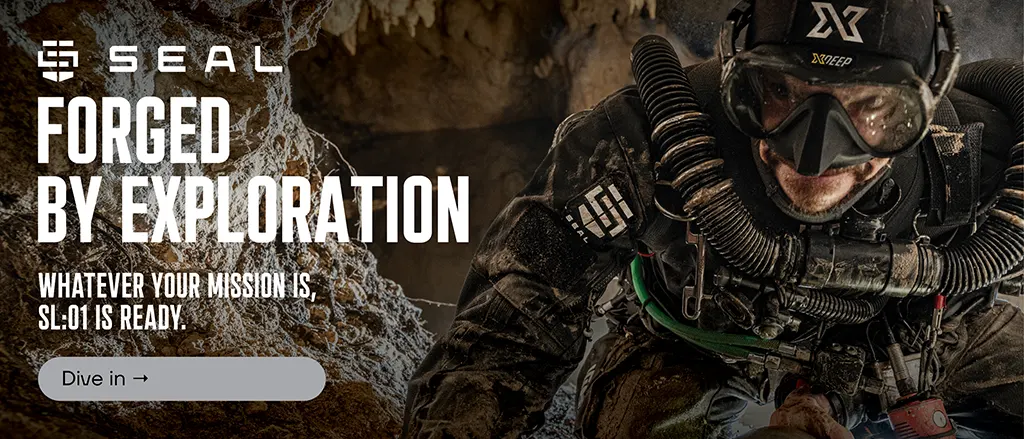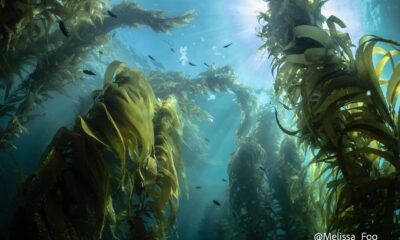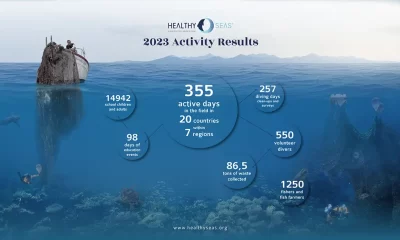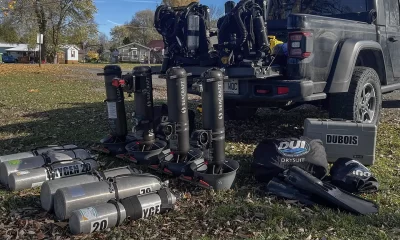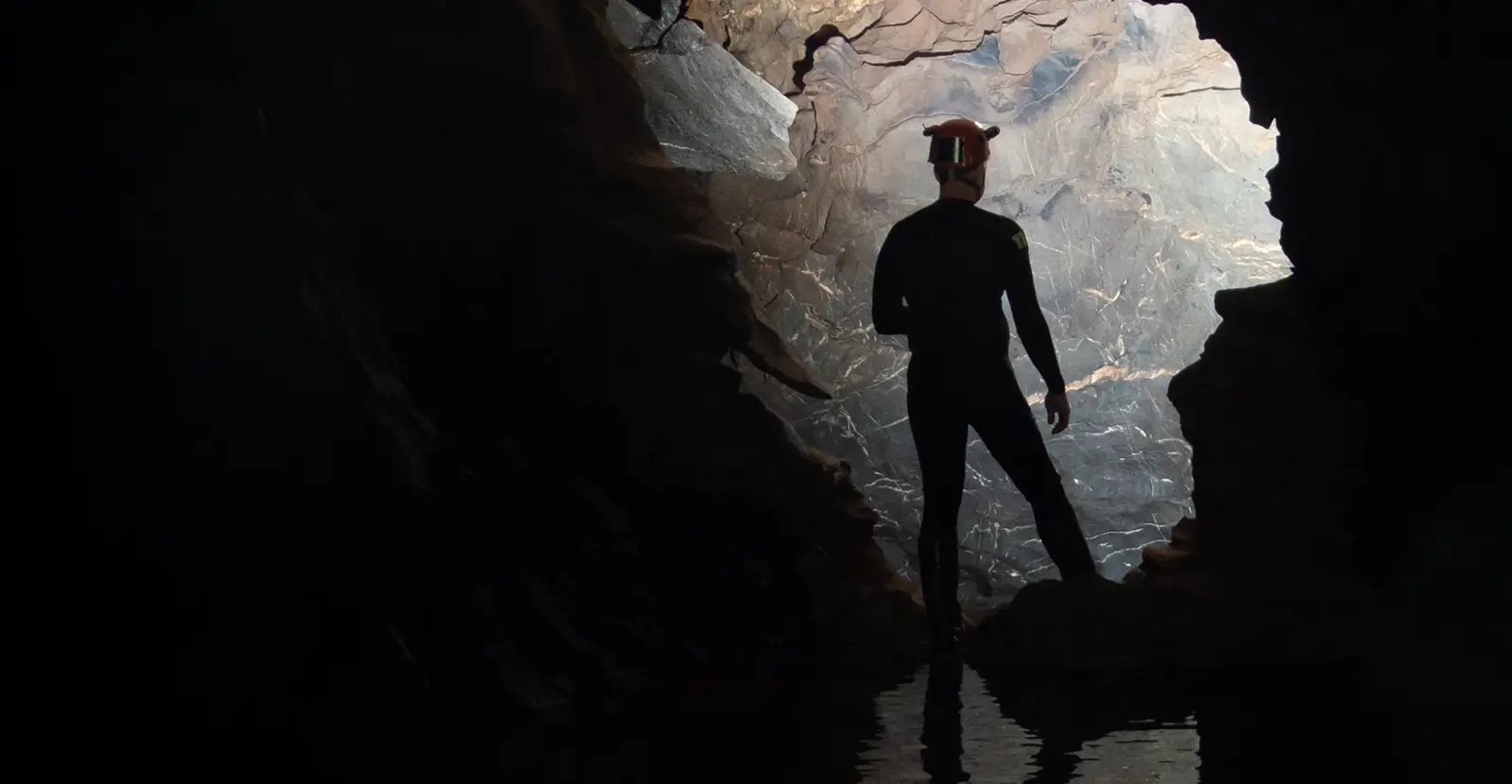
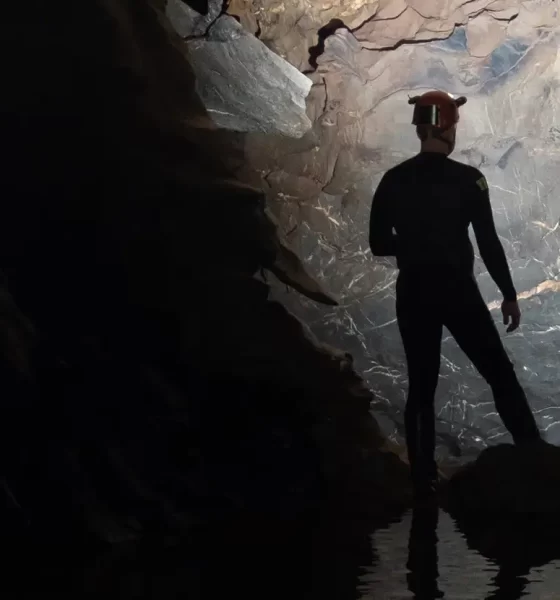
Cave
British Invasion—Thailand Karst Edition 2024
The British are coming? No, they’ve come and gone. The consequence of a 20-year tradition of exploring Thai caves. According to Michael & Rob Thomas, this year was particularly productive for the team, which drew from the Shepton Mallet and Wessex Cave Clubs, and the notorious Cave Diving Group (CDG). The Brits were able to extend the three sumpy caves that they discovered in 2023, all of them with going passage, thanks to streamlined configurations and improved gas logistics. How do you spell, C-H-O-2-P-T-I-M-A? Here is the Thomases’ bootylicious blow-by-blow.
By Michael Thomas and Robert Thomas Photography by Craig Holdstock unless noted. Header image: Nick Ashford in Tham Nam Pu.
🎶 Predive Clicklist: Queen – We Will Rock You 🎶
All caves that were visited require permission from the National Park Service or the Monks if a shrine cave. Cave locations have not been published to deter non-exploration visits. It’s not impossible to obtain permission but it takes time. If interested in cave exploration, research on local access is critical.—Michael Thomas
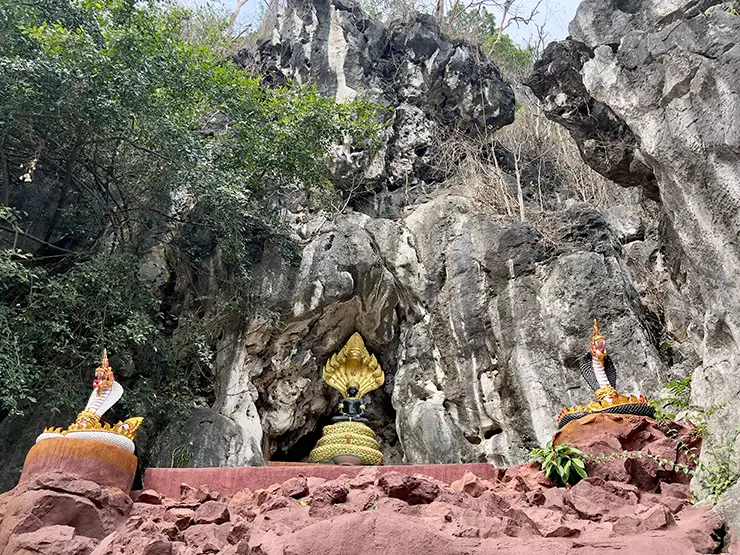
There is a twenty-plus-year British tradition of exploring the caves of Thailand, where the dry season coincides with UK winter. The weather, along with huge amounts of karst and the potential for exploration, make Thai caves a popular expedition destination for cavers. Martin Ellis, who lives in Thailand and is from the Shepton Mallet Caving Club, runs the extensive Thailand cave database and keeps the in-country expedition store of equipment at his home.
Back in 2019, we started talking with Martin about diving in Thailand. He knew of many caves that ended in sumps and, for the dry cavers, this was the end of the cave. World events then took over, and it was not until 2023 that we got a team of divers into Northern Thailand to start exploring the dive sites on our list. The 2023 season was successful, and we planned a return in 2024 to continue the exploration. This time, however, we’d use CCR to ease the logistical problems of remote diving and extend our exploration range. Robert and I flew out to Florida in November 2023 to crossover onto Dive Rite chest-mount CCRs.
Members of the Shepton Mallet Caving Club, Wessex Cave Club, and Cave Diving Group (CDG) returned to the field in Northern Thailand between February 21 and March 10, 2024. Team members included expedition organiser Martin Ellis, Nick Ashford, CDG team doctor Craig Holdstock, CDG’s Michael and Robert Thomas, Malcolm Foyle, Paul & Tiggy Dummer, Thomas Williams, and Phil Collett.
It took the team three days of travel from London to Chum Phae District, Thailand. We met some of the team in Lom Sak who had been in the far north of Thailand exploring caves. All baggage accounted for, we collected diving cylinders and sofnolime for the rebreathers at Sea Scout Diving Centre. Four forgotten jubilee clips for the cylinders were sorted with minimal drama in the local hardware store. An afternoon of equipment sorting and rebreather building put us ready to start work in Tham Nam Lai cave the next day. This was the last cave explored in 2023 and had open leads in both ends of the cave.

February 25, 2024:
A good effort by the assembled company and the luck of being able to drive very close to the entrance this year got all the equipment for the divers to the changing area just inside the entrance at the start of the lake swim. The divers plus Malcolm, Paul, Tiggy, and Thomas then swam all equipment across the lake to the start of the cascades.
A CO2 monitor was used to check the air quality. Immediately, alarms of 3% CO2 registered confirming what we suspected from last year. Note due to the surrounding vegetation and high heat in the dry season with air temperatures of 36-40ºC, carbon dioxide is found in many Thai caves, sometimes in dangerously high levels. For that reason, the use of a CO2 detection monitor is essential to check the safety of the cave at the dive base. We suspected that some caves we visited in 2023 had CO2 issues, with divers developing elevated breathing rates in the caves.
The divers plus Thomas then carried all equipment to the dive base, arriving hot, sweaty, and uncomfortably out of breath. Luckily, ten minutes of resting in the water allowed us to work normally again. Robert was to dive through and continue up to sump 1a and dive that, supported by Nick and Craig. CO2 was found to be worse on approach to sump 1a. Robert was duly launched into the sump, laying line across from the existing line to inspect the (so far unseen) right hand wall, but unfortunately no underwater continuation was found. The diver then surfaced to have another look at the chamber found last year beyond sump 1a before returning to Nick and Craig.
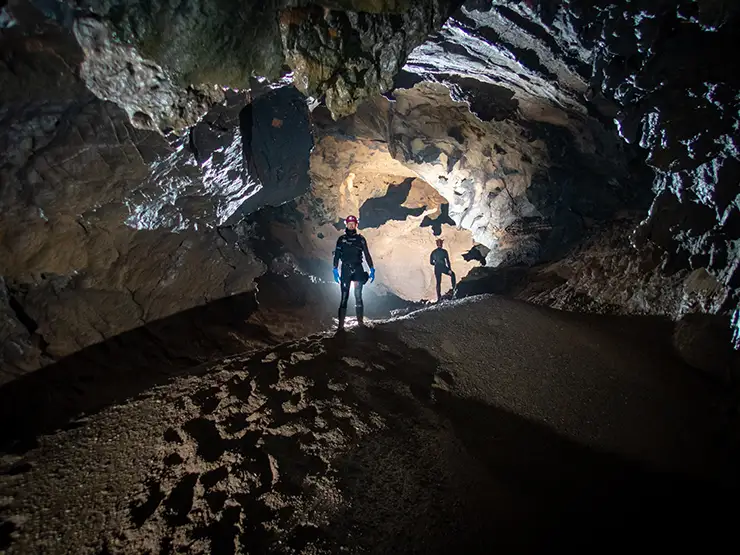
Meanwhile, I set off diving into sump 2; the 20 m of line I laid last year was broken, indicating high flow. Line repaired and new line attached, I continued through sump 2 to surface in a very short, shallow canal and straight into sump 3. This, again, was short and surfaced in a small chamber. In trying to walk fully kitted across a short rock step I got cramps in both legs due dehydration from the earlier equipment carrying efforts. The line was tied off and a return made. Eighty meters of line was laid. The diver was concerned about the air quality in the passages between the sumps so remained on the rebreather loop breathing nice levels of oxygen. All divers headed back to base and left equipment in the cave apart from two used cylinders that we removed.
February 26:
The four divers entered the cave carrying two more cylinders. A much easier trip to the dive base followed. Robert and I set off into sump 2 and quickly reached sump 4, found yesterday. Robert tied the new line in and set off exploring the cave. The passage continued down at forty five degrees with a fairly large diameter; 115 meters of line was laid down to a depth of 40 m/130 ft. This was the depth limit of the divers’ gas that day.
Diver tied off the line and looked longingly down into the continuing cave. I then surveyed out with Robert, lighting my work area in decreasing visibility. Nick and Craig had been back into the passage leading up to sump 1a to take some photographs. All divers then exited the cave, removing most diving equipment except one set of cylinders to be used for some biological sample work. On reaching the surface, we found the jungle on fire and park rangers in attendance—as surprised to see us as we them! We found it was a controlled burn and they told us to go home, but in a friendly way.
February 27:
Needing a slightly easier day and thinking it best to let the jungle fires die down, we visited Wat Pa Tham Nam, a Buddhist shrine cave dived by Nick Ashford. The cave and diver were duly blessed by the congregation before diving commenced. Unfortunately, the sump was completely full of mud at 4 m depth. The diver explored the surrounding walls, noticing one small tube that a large catfish swam into. Diver attempted to enter, but was unsuccessful due its small size. Dive line was removed. We then moved over to Namphut Hin Lat: a spring of incredibly clear water rising in the middle of the plains. Water rose with vigor from between rocks. An hour of digging ensued with minimal diving equipment.
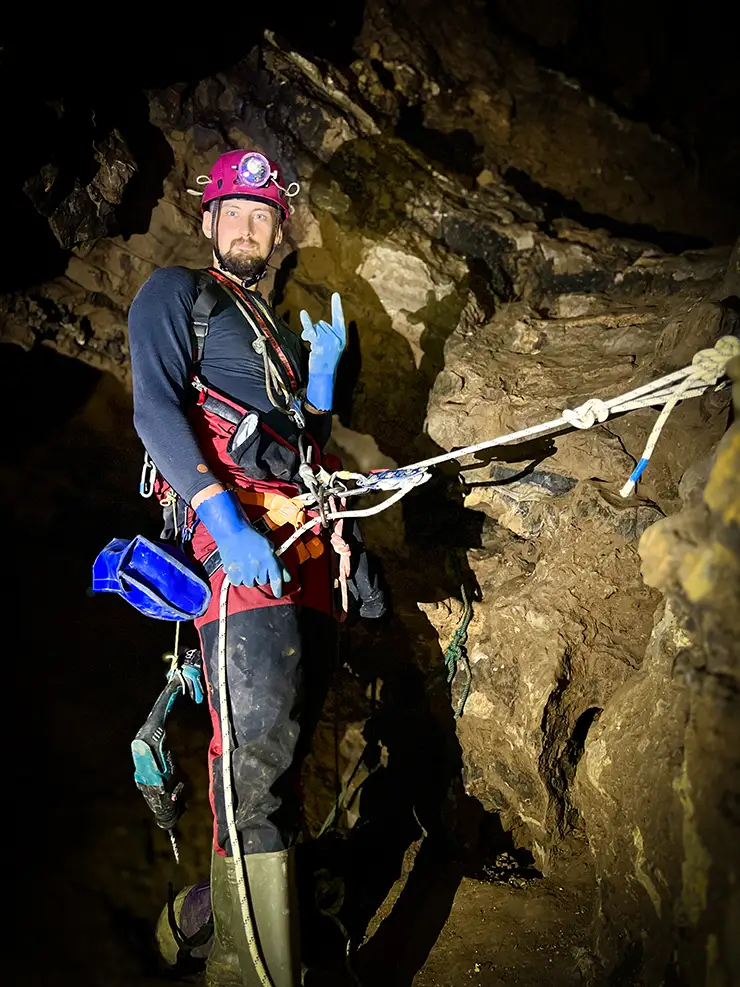
February 28:
Our plan was to return to Tham Nam Lai and conduct some fish science! But on arriving at the cave, we found the trail to the entrance completely swept clean and all dive equipment that had been left at the changing spot underground removed! We concluded that our friendly park rangers had decided we were a problem. A phone call later brought us to the large boardroom table of the region’s head ranger in a lovely park service building. We spent an hour explaining what we were doing—as in exploring caves, and not stealing fish to sell on the illegal aquarium trade, which is unfortunately a real problem in Thailand.
Once the boss was happy, our equipment was returned with a smile. Unfortunately, all the bolt snaps and rigging on the cylinders had been cut off and obviously re-purposed for who knows what. Slightly frustrating to say the least. We were granted permission to do one more trip into the cave to recover the last of the equipment staged at Sump #1. Nick and I did the equipment recovery and spotted a large and rather superb cave racer snake in the swimming section. The afternoon’s entertainment was back at Namphut Hin Lat with more boulder removal from the underwater spring dig. A much more relaxed time with 5 meters of progress underground.
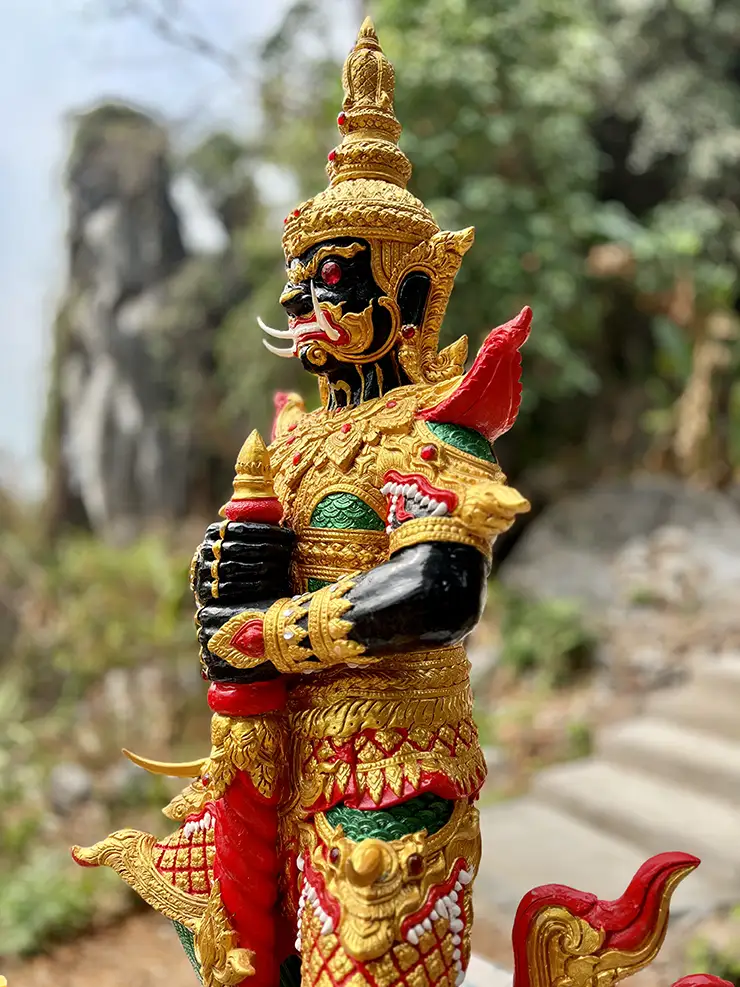
February 29:
Wat Tham Prakai Pet: yet another cave with a Buddhist Temple in the entrance. The monks granted permission, and the team set off to investigate the two ends of the cave that were question marks on the survey. The right-hand branch ended in a supposed 20 m/66 ft drop, and the left hand branch ended in a 7 m/23 ft drop into a rift passage. Robert started rigging the right hand pitch, supported by Thomas.
The pitch was found to be 35 m/115 ft deep in poor quality rock, making the rigging interesting. The base of the pitch was found to be a mud choke with no way on. The team then moved over to the left-hand branch and, with Thomas rigging, we dropped over the edge. With a slippery and rather run-out traverse along the wall, we arrived at an alcove with some safer ground. We saw several ways on, with the best option being a hopefully deep clean washed shaft in a rift passage. The traverse line was left in situ and the team exited to sort more equipment and rope for tomorrow.
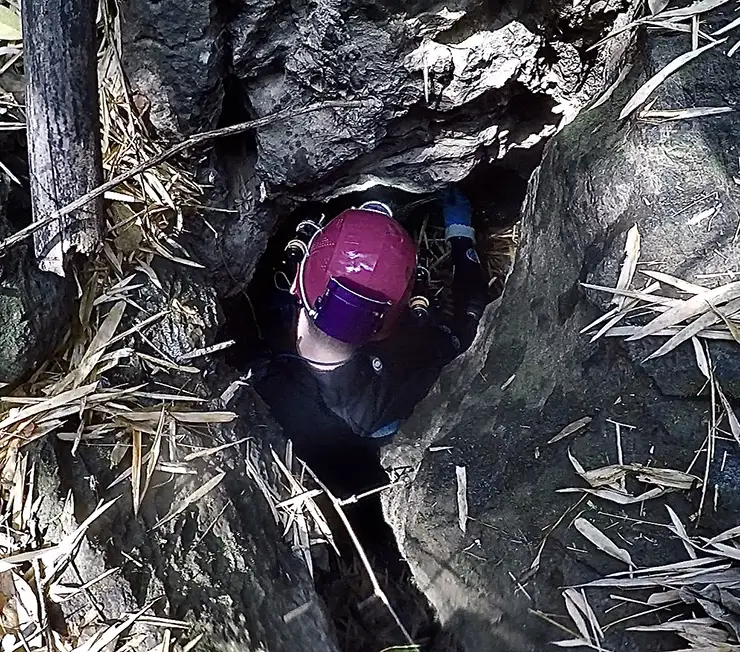
March 1:
Spent the morning obtaining oxygen for the rebreathers in a Thai oxygen distribution center—human factors and the Health and Safety Executive (HSE) need not apply. I then caught up with Malc, Craig, Paul, and Tiggy in Tham Satchatham. This large and impressive shrine cave needed surveying and photographing. A stiff uphill walk in the heat of the day from the car was well worth it. Huge chambers and formations remind me why we go east. Meanwhile, the Wat Tham Prakai Pet team of Robert, Nick, and Thomas dropped the pitch found yesterday—unfortunately, it also ended in a mud choke around 30 m/100 ft down.
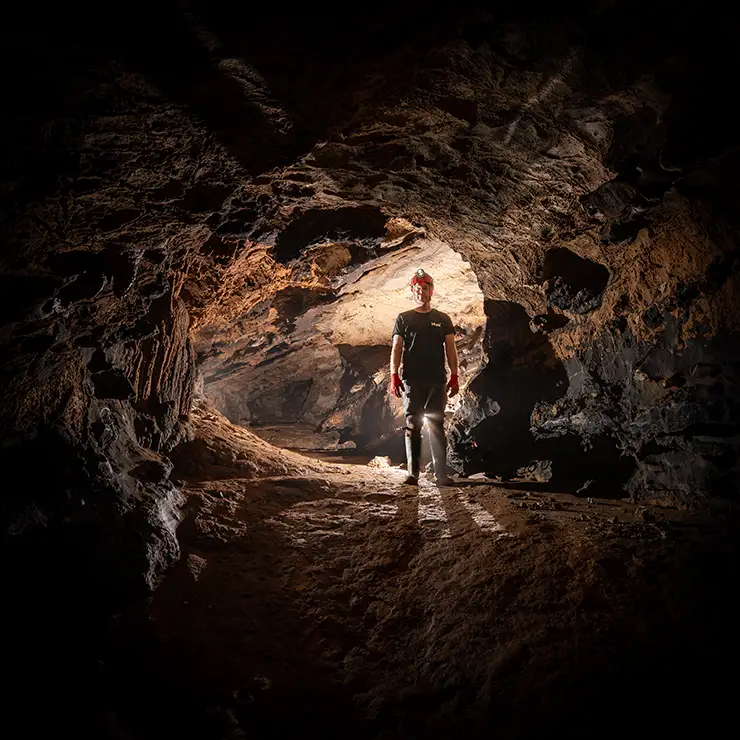
March 2:
We revisited the Tham Huang Po Resurgence cave from 2023 that was a living version of wildlife hell. Fortunately, this year the prospects of success seemed much higher. With reduced flow and cleaner air, Robert, Michael, and Nick began assessing the site. In mostly good spirits, the kit hauling began after a reconnaissance mission to the sump. After passing Robert’s equipment through the small entrance beyond the big boulder, soon we were swimming. Three ducks break up the 250 m/820 ft of deep water, swimming to the previously known end.
Arriving with equipment, Robert realised his backup lights were still in the car. Nick championed the return journey in a thirty five minute round trip. Robert was ready for departure as soon as his backup lights were re-attached to his helmet. The murky water in the pool gave reason for concern. The size and shape of the passage indicated that the only reason the sump wouldn’t go is a lack of ability or nerve.
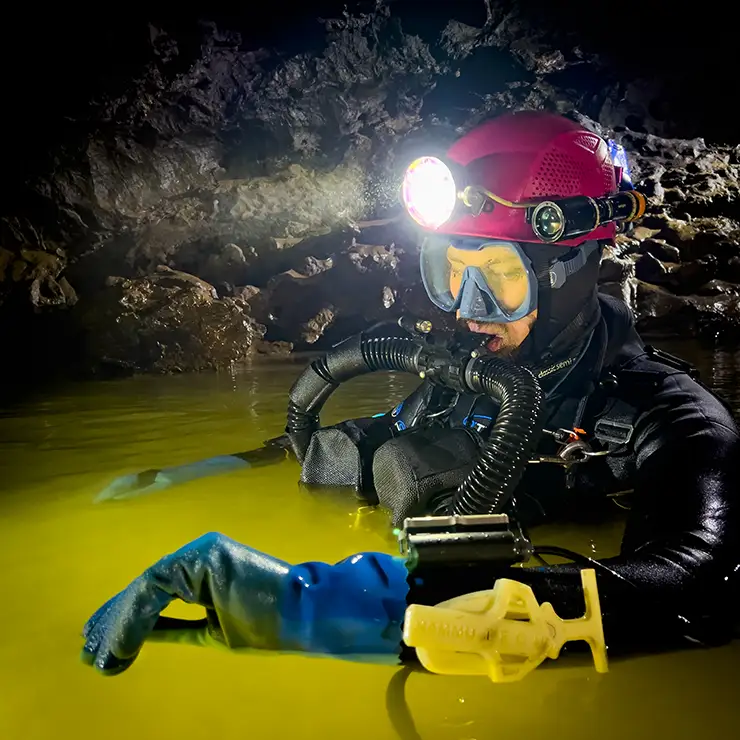
Following the right hand wall, Robert descended on the Dive Rite rebreather to a depth of 5 m/16 ft where winding mud walls, jagged outcrops, and claustrophobia-inducing passage made for challenging diving. Surfacing in a small air bell, Robert corkscrewed back into some form of flow; visibility (at best) was 2 m/6 ft in the passage estimated to be 6-8 m/20-26 ft wide.
Soon, we again found the roof on the left hand side; it led onwards for some 80 m/260 ft where a bold tie off was made to an ascending slope.
Double-checking the line wrap, we made an ascent from 12 m/40 ft with the divers popping out of the roof into the floor of the chamber above, finding crystal clear water and increased flow. Now able to see the full scale of the room, Robert was content. Again winding upwards towards the surface, the left hand side of the pool was checked to an end… Where the diver surfaced in a larger air bell. We predict that the “Ellis Hall ” passage continues in a northeasterly direction in clear water. Robert—on an hour’s dive time limit due the CO2 absorption of the rebreather—tied off at 1 m and surveyed 197 m/646 ft of passage back to the waiting team. This was a mentally stimulating dive into a seemingly live aquifer.
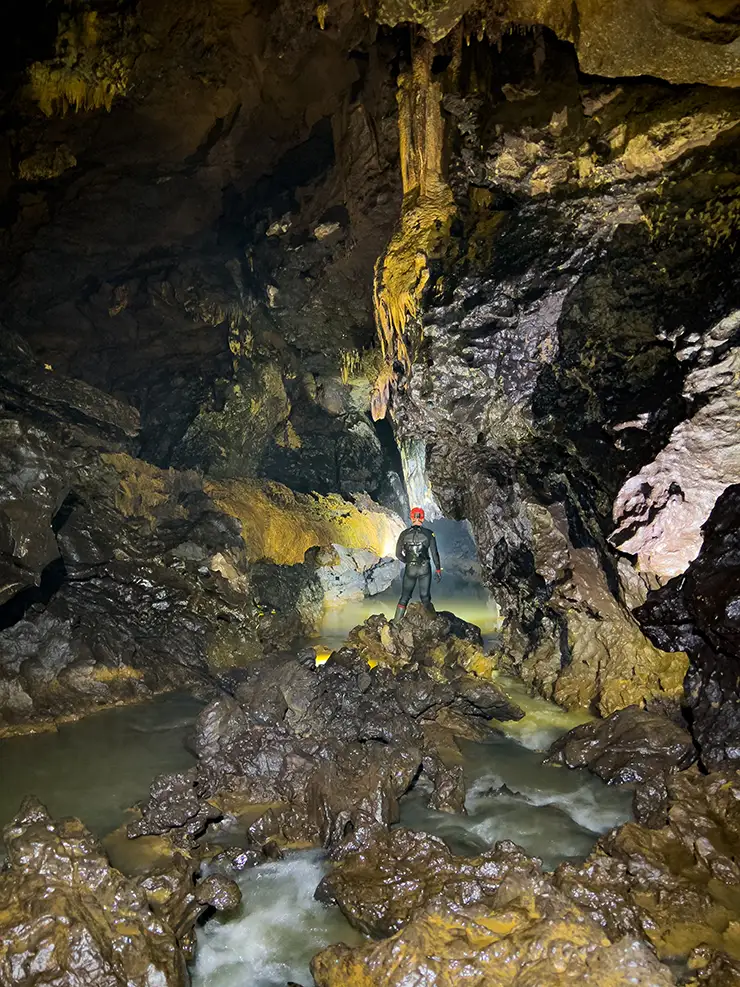
March 3:
We endured another dive in Tham Huang Po Resurgence, but conditions were poor. Hopes of clear water were soon squashed. Robert, supported by Michael, made it to the end of yesterday’s line with one safety snoopy loop installed holding onto an acute line wrap. Visibility had done nothing but worsen in the pool, which was seemingly a clear cap on top of a flowing jungle mung river.
Communication was difficult in zero visibility, and the dive was aborted after two failed attempts of searching around the pool for a way onwards. Some flow was found. Soon after, however, we also found the inbound line, indicating that the passage likely continued below the lip of the chamber. The large passage and challenging mud walls were not ready to give up their secrets today—an unpleasant dive all around. Certainly the cave does go; however, we recommend a longer gap between pushes to allow all the water to settle. Even so, a pretty grim cave.
March 4:
A change is as good as a rest, so we moved 100 km north, closer to the Laos border. After settling into a new home with a rather chilled out vibe in a nice mountain area, the divers went off to find our project cave. Tham Nam Pu, Nong Hin District, Loei Province. It was last dived in 2012 by a technical dive team from Southern Thailand. From the Resurgence, they explored 350 m,148 ft of underwater cave and surfaced in a boulder choke (but never got out) in the left hand branch; and, in the right hand branch, the cave continues unexplored underwater.
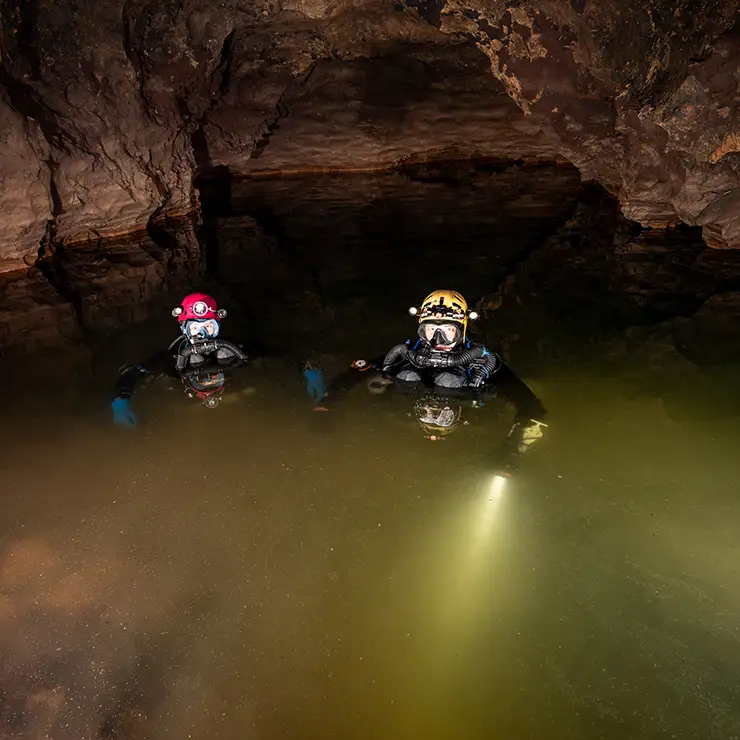
A middle entrance leading to a large dry cave passage bypasses the first 200 m/650 ft of diving cave. This would be our start point for pushing the cave. We located the entrance and scouted out the approach. We explored the rather fine section of dry cave as well as the dive base. Large bats were in residence, and a cave racer snake was located down by the underground river. The divers looked forward to starting work here.
March 5:
Both divers reached the base after a very speedy carry over the short section of dry cave in the middle entrance (which required rigging a hand line on a 5 m ramp). All team members assisted. Robert located the dive line, and both divers set off down the initial canal section. Several line repairs were made, and the divers soon reached the junction of left and right branches. Robert tied on a line reel, as the line to the surface was mostly gone. We then ascended up a mud slope and surfaced—not in a boulder choke chamber as expected, but in a mud choked room with several large cave creatures for company. Obviously this was not the original choke found.
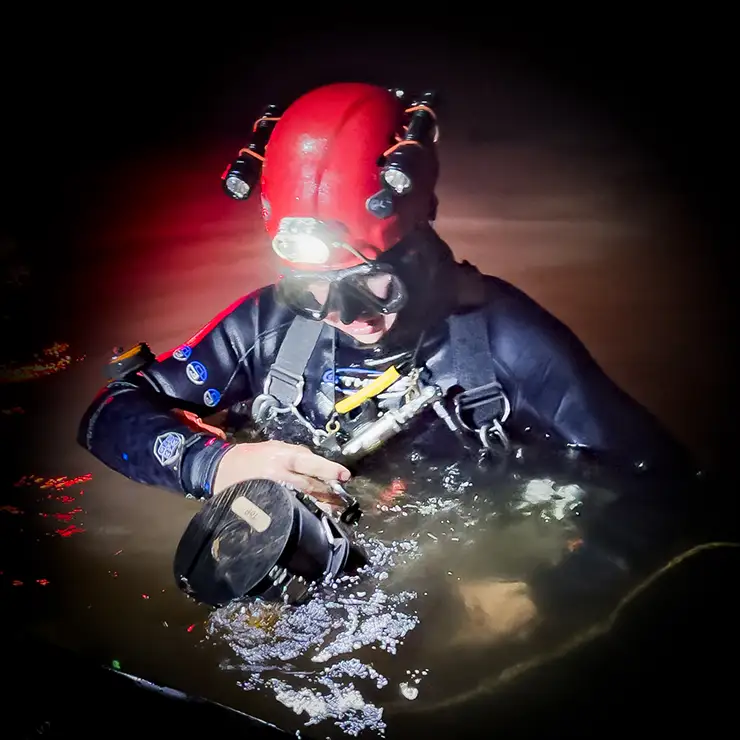
Unfortunately, once divers returned to the main line, visibility had reduced to zero. Both divers returned to the canal passage to discuss options. Robert waited in the canal to support me as I checked the line, cleared the old and broken line (in zero visibility), and reached the old end of line in a slightly improved 1 m visibility. We confirmed a continuation and headed out. I noticed a window with better visibility going up on the right. This may have been the way up to the boulder chamber. I placed a marker and hoped that visibility would clear overnight for a better look tomorrow. Both divers returned to base after a stressful 90-minute dive.
March 6:
With excellent help, I was in the water by 9:30 am to miss the worst of the Thai daytime temperatures. We set off to try and make sense of what we thought we accomplished on yesterday’s dive. Arriving at the junction area in better, normal visibility of 1-2 m, we carried on to the end of the line in the right-hand branch. We tied on a new line and followed the left hand wall. After 25 m/82 ft, I found the line I swam in on: this confirmed that the right-hand branch was just part of a large passage, not a separate passage. We removed our line and returned to the junction area. I attached a line and proceeded to head up into the large passage of what was called the left-hand branch.
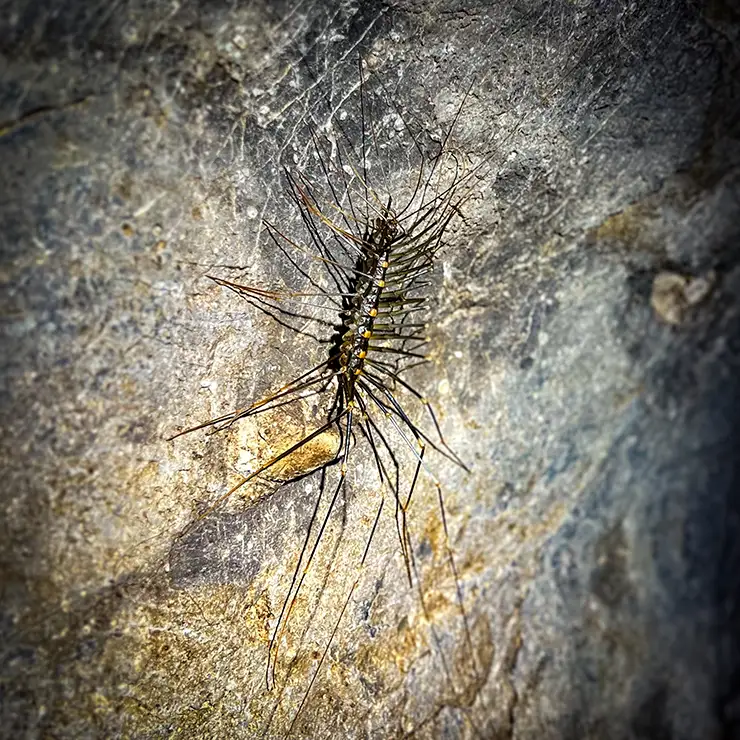
After 30 m/100 ft, I found a section of the original line from 2012, tied my line in, and followed this to surface in the alleged “boulder breakdown” area. On seeing large passages and formations, I de-kitted and walked down 30 m of a rather nice chamber following the river “Ola Hall” to another sump with all the river emerging. Happy to have sorted the confusion and found the way on, I returned to base and my equipment swiftly disappeared back to the truck.
March 7:
Setting off down the canal, a seven-minute dive gets Robert with Nick in support in the head pool of Ola Hall where Michael had gotten out of the water yesterday to establish a 31 m/102 ft long chamber with high flow from the new found sump 2. First de-kitting, then using a knotted line to establish survey data through the dry section of the passage. Nick, having never been in a virgin cave like this before, clearly in ore but very focused. Survey data collected and equipment carried over the 31 m/102 ft of shiny, jagged rocks. Robert was kitted up in the 5 m x 5 m/16 ft x 16 ft sump pool ready to descend within the hour.
With limited visibility at the best of times (2m/7 ft) Robert followed the left-hand wall at ceiling level. Descending steeply to a gravel base at 15 m/49 ft. The walls were smooth and mostly free of good line belays, and the line was run out. Passage was still easily 10 m/33 ft wide, only 0.5m high, passing a 30 m/98 ft section of low groveling, back-on-the roof, front-on-the floor style diving. As soon as any movements were made, zero visibility engulfed us. Fortunately, there was enough flow for the gravitational effect of the silt not to overcome the diver. Popping back into a bigger passage at 27 m/89 ft, the left hand wall ended in a mud slope, crossing the lip of the elbow to the right hand wall.
The passage was very large in size and ascended at a 30-40° angle. More smooth walls and sandy floors were followed to a depth of 15 m/49 ft where the diver had reached their limit for this trip. An arrow placed on the line a little before the final tie off went some way in, showing the pause for thought of whether the diver continued or not. The end is an ongoing lead 480 m/1575 ft from the resurgence.
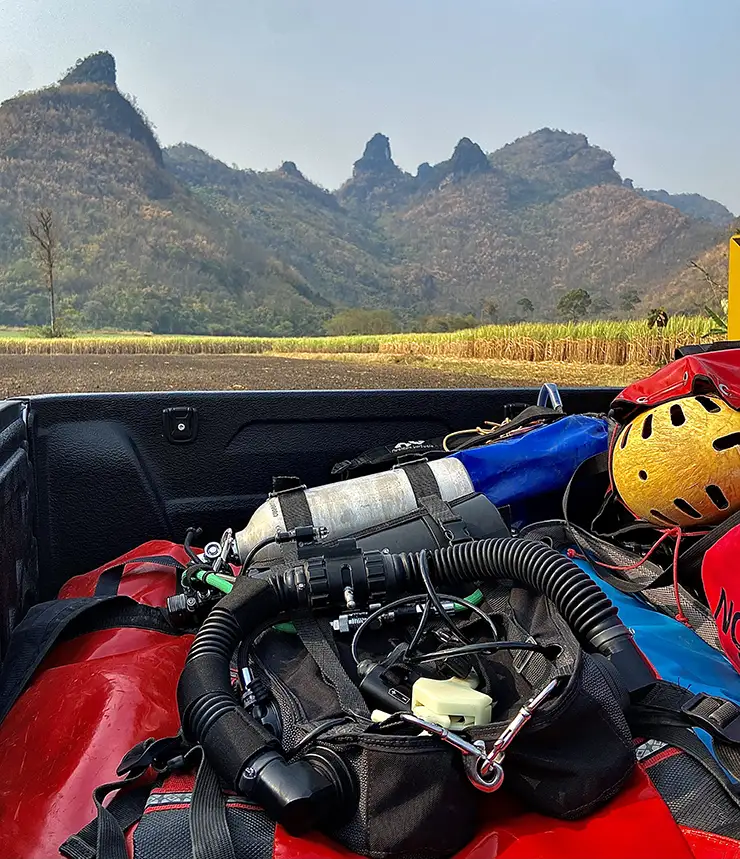
March 8:
Our final dive day. Craig and Michael had a relaxed dive through to Ola Hall to photograph the find. Cave shrimps and crab spotted on the exit. Over the last two weeks we have explored three caves that involved some fairly difficult diving. All three caves we extended and confirmed the caves still continue, two go deep and one in a confusing and large chamber. Visibility in the Jungle caves was only 3 m at best and mostly 1-2 m.
Team diving is inefficient and basically dangerous in these conditions, so we opted for a semi solo approach with a diver in support of the push diver waiting at the known end while the push diver would lay line and survey.
With water temperatures of 24ºC and some strenuous caving to reach the dive sites, often in a cave environment with high C02 our chosen suit was the O’Three 3 mm combined with a deep skin vest. Long wetsuit socks and Wellington Boots. We were comfortable even with dives down to 40 m/131 ft.
Gas logistics in northern Thailand are difficult, so we chose to use Dive Rite chest mount CCR aka the CHO2Ptima. We also had cylinders of air and 32% nitrox as bailout and diluent. Apart from tending to a few cuts and bruises, our doctor could concentrate on photography. Now that it’s over and the data has been collected, we can start planning the next steps.
DIVE DEEPER
InDepth: Meet the British Underground by Michael Thomas
InDEPTH: The Who’s Who of Sidemount: Michael Thomas
InDEPTH: Where have all the young divers gone? Meet Rob Thomas and Young Divers International by Amanda White
InDEPTH: Discovering The Longest Fresh Water Cave In Thailand by Mikko Paasi
InDEPTH: A First Exploration of the Flooded Mines of Thailand by Mikko Paasi

Michael Thomas is the Training Officer of the British Cave Diving Group (CDG) Somerset Section. The CDG is credited with being the first organization to develop sidemount diving in the early 1960s. Mike is an avid promoter of sidemount and cave diving and he is also a Full Cave instructor, and a sidemount and tech instructor with TDI. In addition to being a Fellow of the Royal Geographic Society, he is on the British Cave Rescue call list. His primary focus has always been cave exploration and cave diving, both at home in the UK and in foreign lands. When not working on his own diving projects, I teach technical and cave diving full time.

Robert Thomas—I’m guessing underwater fireman is an inappropriate term for a tech diving professional. By the time this sees print, I will be in my 18th year of diving, six of those have been in teaching status. From open water to Intro to cave, not forgetting the joys of JJ-CCR. The thrills keep going; they just get further from home. After another successful Thai expedition, departure is imminent; continuing the next chapter of teaching Tech with Trawangan Dive, deep in the heart of Indonesia’s Gillies.


